Obama gives White House solar panels (another) moment in the sun
Loading...
Solar panels have returned to the White House roof, the Obama Administration announced Friday, capping off a week of energy and climate change initiatives.
Another initiative he announced Friday: More than 300 private and public organizations have also committed to boosting solar power and efficiency upgrades, according to the White House, joining in the Obama administration’s efforts to cut carbon emissions and energy waste.
Having begun the week with a sobering assessment of climate change’s impact, the White House finished the week with proposed solutions to the challenge of rising greenhouse gas emissions. It is part of an effort to win public support on climate issues that will likely factor into this year’s midterm elections.
"One of the biggest factors in bringing back jobs in America has been our commitment to American energy over the past five years," President Obama said at a Walmart in Mountain View, Calif., that has adopted clean-energy and energy-efficiency improvements. "We’re producing more traditional energy, but we’re also becoming leaders in the energy sources of the future."
"Every four minutes another American business or home goes solar and every panel is pounded in by a worker whose job cannot be shipped overseas," Mr. Obama added.
Friday was not the first time solar panels have appeared on the White House roof. In 1979, President Jimmy Carter installed 32 solar panels for heating water at 1600 Pennsylvania Avenue, but they were quietly removed by the Reagan administration during a roof resurfacing in 1986.
President George W. Bush was the first to install a solar-electric system on White House grounds, adding 9 kilowatts of photovoltaic panels to a maintenance building. In 2010, the Obama administration announced it would be returning solar power to the White House roof, which it completed Friday.
The new, American-made panels amount to 6.3 kilowatts of solar generation as part of a broader White House retrofit that includes updated building controls and energy-saving, variable-speed fans. The average size of a residential solar photovoltaic system in the US is 5 kilowatts, according to the trade group Solar Energy Industries Association (SEIA).
“The project, which helps demonstrate that historic buildings can incorporate solar energy and energy efficiency upgrades, is estimated to pay for itself in energy savings over the next eight years,” White House spokesman Matt Lehrich wrote in an e-mailed statement. The White House declined to offer specifics on the building’s total energy consumption.
The administration also issued two new efficiency rules Friday for electric motors and walk-in freezers and coolers, like those used at supermarkets. The standards are expected to cut carbon emissions by about 158 million metric tons and save consumers over $26 billion through 2030, according to the White House.
Google, Ikea, Apple, and a broad range of other private companies also announced solar and efficiency measures that together represent more than 850 megawatts of solar power deployed – enough to power nearly 130,000 homes. Walmart pledged to double the number of on-site solar energy projects at its US stores, Sam’s Clubs, and distribution centers by 2020.
“We know from experience that investing in energy innovation allows us to save money, reduce carbon pollution, and create jobs,” Bill Simon, president and CEO of Walmart U.S., said in a statement Friday. “Every day, millions of Americans depend on us to watch every penny so that we can provide the best prices on products they love. Our customers can feel good that we’re watching out for both their wallets and their children’s future.”
Solar remains a tiny fraction of the nation’s overall energy mix, but Friday’s announcements underscore remarkable growth in the sector, and the potential for future technological development.
The precipitous drop in the cost of solar power has helped boost the small but rapidly growing US solar industry. The average price of a solar panel has declined by 60 percent since the beginning of 2011, according to SEIA. New solar photovoltaic installations installed grew 41 percent last year over 2012 installation levels, and accounted for 29 percent of all new electricity generation capacity added in 2013.
"I am very bullish on the future of solar energy as a key part of our clean energy future," US Energy Secretary Ernest Moniz said in a video about the White House solar panels.








